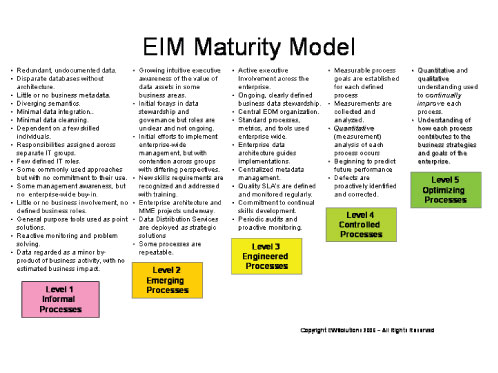Enterprise Information Management Maturity: Data Governance’s Role
By Anne Smith
The Software Engineering Institute (SEI) developed a “Capability Maturity Model” (CMM), based on the work of Watts Humphrey at IBM. A maturity model strives to assist organizations in improving the quality of their software development through implementation of processes that are “mature”, meaning that these processes have a high predictability of results and low risk of encountering unknown variables or situations. The model takes an organization through five scales, from Level 1 (Initial) through Level 5 (Optimizing), and measures the operation’s effectiveness at each level based on assessment of certain areas.
The CMM has become the basis for many models that are designed to show the current state of an organization’s effectiveness in a certain area (human resources, networking, etc.) and to serve as a guide for the improvement activities. The model states what should occur at each level, not how to accomplish the activities. The methods of instituting improvement can be considered as an appropriate activity for a governance council.
Many organizations are investigating the development of an Enterprise Information Management approach to their information assets. This can be a daunting task, and since many organizations do not know where to start they do nothing. Analyzing the organization’s current state and desired state with a maturity model for EIM could provide a framework for arranging their activities and managing their expectations, and enable them to proceed with confidence in their capabilities and needs.
Levels in any maturity model are based on the levels established by the SEI’s Capability Maturity Model (CMM). Briefly describing the levels: (fromhttp://www.dis.wa.gov/portfolio/tr25/tr25.html)
- Initial Level (ad-hoc, immature): At the initial level, the organization typically does not provide a stable, consistent environment for the analyzed activities (software development, human resources, EIM, etc.). When an organization lacks consistent project management practices, the benefits of good integrated practices are undermined by ineffective planning and reaction-driven commitment systems.
- Repeatable Level: At the repeatable level, policies for managing a project and procedures to implement those policies are established. Effective management processes for projects are institutionalized, which allow organizations to repeat successful practices developed on earlier projects, although the specific processes implemented by the projects may differ.
- Defined Level: At the defined level, the standard process for developing new products is documented, these processes are based on integrated product development practices, and these processes are integrated into a coherent whole. Processes are used to help the managers, team leaders, and development team members perform more effectively.
- Managed Level: At the managed level, the organization establishes metrics for products and processes and measures results. Projects achieve control over their products and processes by narrowing the variation in their process performance to fall within acceptable boundaries. Meaningful variations in process performance can be distinguished from random variation (noise).
- Optimized Level: At the optimized level, the entire organization is focused on continuous process improvement. The organization has the means to identify weaknesses and strengthen the process proactively, with the goal of preventing the occurrence of defects. Data on the effectiveness of the development process is used to perform cost benefit analyses of new development technologies and proposed changes to the organization’s development process. Innovations that exploit the best-integrated product development practices are identified and transferred throughout the organization.
Developing a new maturity model is a time-consuming task, and requires the development team to have experience in all areas of the discipline (e.g., software development is one discipline, enterprise information management would be another discipline), as well as experience in maturity model development. A premier enterprise information management consulting company, EWSolutions, has developed an EIM Maturity Model that can serve as the model for any organization that would like to assess and track progress in their EIM initiative.

Managing the EIM assessment and the improvement processes / projects is the responsibility of the data governance council, assisted by the organization’s data stewards and technical stewards. Many of the activities listed in the maturity model concern the data governance initiative directly, others are tasks that the governance council or the data stewardship teams would oversee or complete. Still other items are the responsibility of management / leadership, influenced where appropriate by the governance mission and its goals. Leadership and the Data Governance Council may set the desired level for eventual achievement and participate in the assessment of the current state of enterprise information management, using an accepted model for measuring and implementation.
Enterprise Information Management requires that a governance effort be established as one of the main foundations of success. Using a maturity model can enable governance to provide direction and a roadmap for moving from Level 1 to an acceptable maturity.
About the Author
Anne Marie Smith is a leading consultant in Information Management and is a frequent contributor to various IS publications. Anne Marie has over 20 years experience in information management for several corporate entities and has successfully led the development of data resource management departments within corporations and consulting organizations. Anne Marie is active in the local chapter of DAMA and serves on the board of directors of DAMA International, and is an advisor to the DM Forum. She has been an instructor of Management Information Systems (MIS) with Philadelphia, PA area colleges and universities. Anne Marie has taught topics such as: data stewardship and governance, data warehousing, business requirements gathering and analysis, metadata management and metadata strategy, information systems and data warehouse project management. Anne Marie’s areas of consulting expertise include metadata management including data stewardship and governance, information systems planning, systems analysis and design, project management, data warehouse systems assessment and development, information systems process improvement and information resource management/data resource management. Anne Marie holds the degrees Bachelor of Arts and a Master's of Business Administration in Management Information Systems from La Salle University; she has earned a PhD in MIS at Northcentral University. She is a certified logical data and process modeler and holds project management certification. Anne Marie can be reached at amsmith@ewsolutions.com